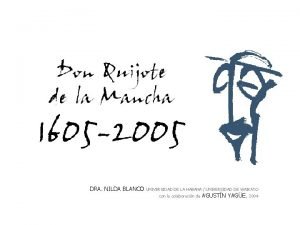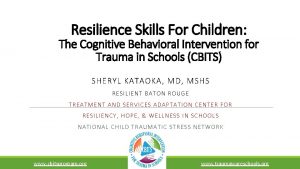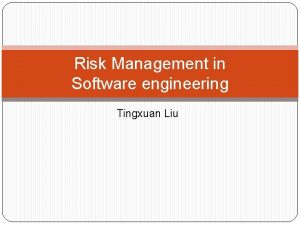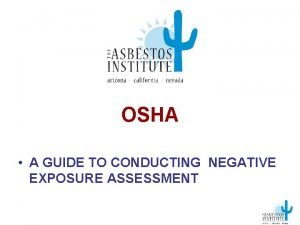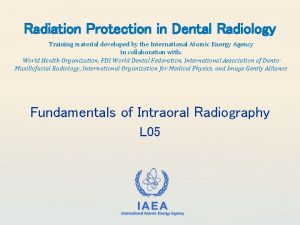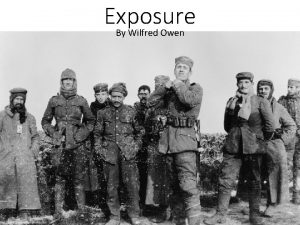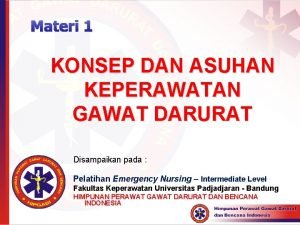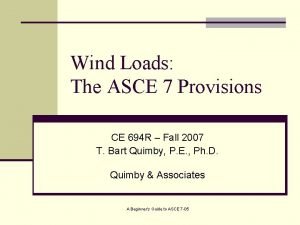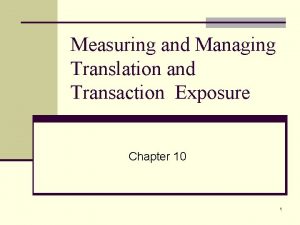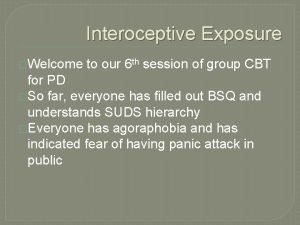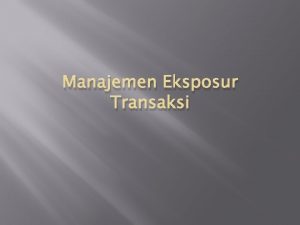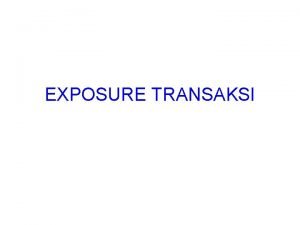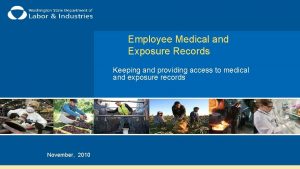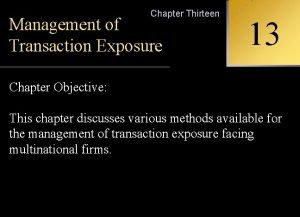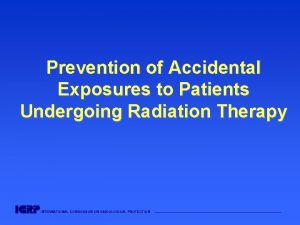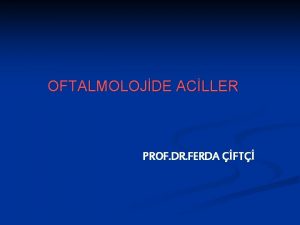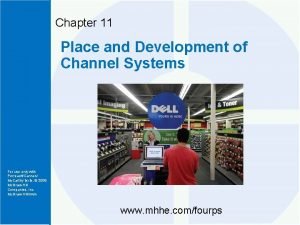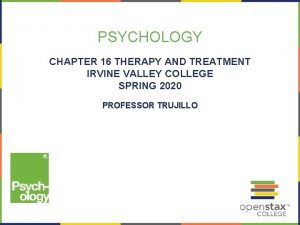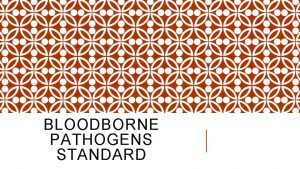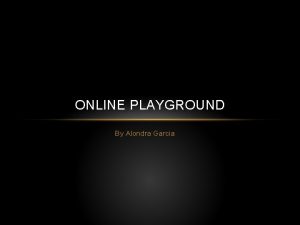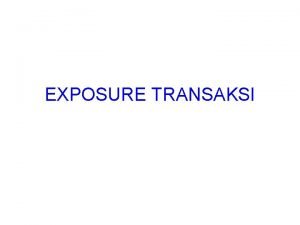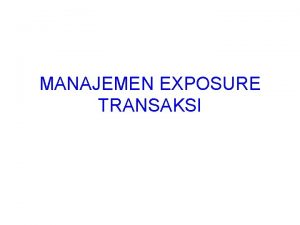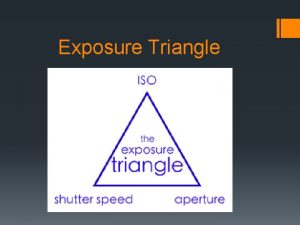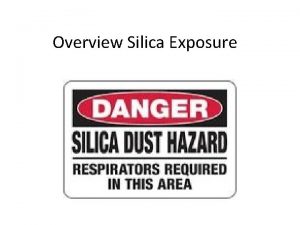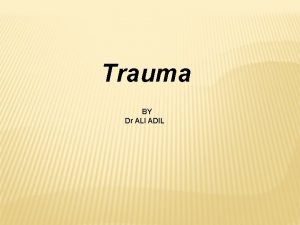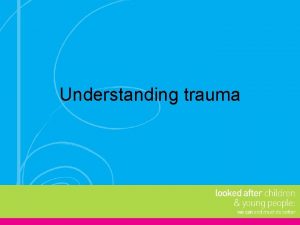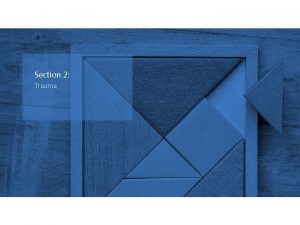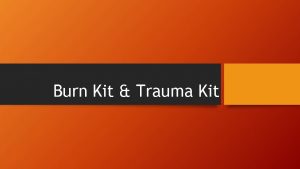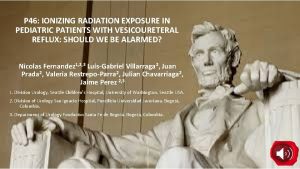Radiation Exposure in Pediatric Trauma Nilda M Garcia









































- Slides: 41

Radiation Exposure in Pediatric Trauma Nilda M. Garcia, MD Trauma Medical Director Dell Children Medical Center-Austin Associate Professor of Pediatric Surgery UT Southwestern -Austin 1

Nuke ‘em Till They Glow

OVERVIEW n n Why do we scan? BEIR Report u Facts u Physiology/definitions/doses n Trauma patient ‘s exposure to radiation u Current u CXR, Pelvis, Brain CT u Screening labs n ACR u ALARA-concept

We scan out of: § Necessity (variable) § Ignorance § CYA** § Laziness**

Diagnostic CT in the USA 1980 3 million scans n 2006 62 million scans n 2006 4 million scans pediatric population n

Radiation Exposure n n 1987 85% from environment and 15% from CT 2006 50% from environment and 50% from CT

Lay Press Too Much of a Good Thing? ; The Growing Use of CT Scans Fuels Medical Concerns About Radiation Exposure From: The Washington Post | Date: January 15, 2008| Author: Rob Stein - Washington Post Weighing the risks of CT scans Newspaper article from: Oakland Tribune ; . . . of all medical radiation exposure to the U. S. population. . . the 62 million CT scans given annually. . . tissue trauma. CT scans, he added, "revolutionized. . . controversial study on radiation exposure from CT scans. . . diagnostic benefit of CT. . .

MORE LAY PRESS n “Hundreds of fatal cases of cancer are being induced in children every year by hospital scans…” u n www. nature. com/nature/journal “F. D. A. to Increase Oversight of Medical Radiation “ u New York Times- Feb 2010 8

What is the risk?

NATIONAL RESEARCH COUNCIL OF THE NATIONAL ACADEMIES -THE NATIONAL ACADEMIES PRESS Washington , D. C. Committee to Assess Health Risks from Exposure to Low Levels of Ionizing Radiation BEIR- Biological Effects of Ionizing Radiation BEIR’s series of reports are the most authoritative basis for radiation risk estimation. The report estimates risks for cancer incidence rates as well as mortality and also provides detailed risk figures according to age of exposure for males and females by cancer type. 10

Biological Effects of Ionizing Radiation (BEIR) n n n. BEIR VII Phase 2 (2006) National Academy of Science n Methodology to estimate lifetime attributable risk of cancer induction associated with low level radiation exposure. Evidence based on long term follow -up of Hiroshima, Nagasaki and Chernobly survivors. 25, 000 Japanese survivors received 5 to 150 m. Sv with a mean of 40 m. Sv.

Physiology of Radiation Injury to Biological Tissue n n n Ionizing radiation. Free electrons. Free radicals. Hydroxyl radicals from water Hydroxyl interaction with DNA. Strand breaks damages base pairs and damages repair enzymes Mis-repairs lead to point mutations, chromosomal translocations and gene fusions Interferes with programmed cell death Mutagenesis and carcinogenesis.

Physiology n n Long lag time from acute exposure and development of malignancy (20 – 25% background incidence) Age, gender and target organ factor. Females more susceptible than males Young more susceptible than old – more actively dividing cells, more dose per gm. tissue and longer lag time Breast, bone, thyroid and lung more susceptible than skin or brain.

BEIR VII Phase 2 Risk of cancer induction proceeds in linear fashion down to a low dose, low energy exposure n Risk of cancer induction linear down to ~50 m. Sv. n Probably no “safe” threshold n n No information on X-ray

Definitions n n Roentgen-beam energy (coulomb/kg) Gray-energy absorbed per unit mass (joule/kg). Useful unit for targeted therapeutic radiation. Sievert-energy absorbed in nonhomogeneous tissue. Useful measure for diagnostic imaging or environmental sources. Dose estimate-beam energy X target factors (age, gender, body size, target organs) Measured in Sieverts

Dose Estimates n n n n Average from environment 3 m. Sv Cosmic source at sea level. 26 m. Sv Cosmic source in Denver. 63 m. Sv Food and water. 40 m. Sv Air (Radon) 2 m. Sv Airport security. 00002 m. Sv TV 0 m. Sv

Dose Estimates continued n n n Hand x-ray Chest x-ray VQ scan UGI Abdominal CT adult Abdominal CT child 0. 01 m. Sv 0. 06 m. Sv 0. 14 m. Sv 2. 5 m. Sv 10 - 20 m. Sv 15 - 30 m. Sv

Dose Estimates continued n CTCA or PE protocol 64 slice u n 50 to 90 m. Sv “Triple rule out” (Coronary Art, Aorta, Pulm artery) u 100 to 180 m. Sv

In a few decades, estimated that 2% of all cancers will be due to radiation from CT scans performed now.


Shock room films: Chest X-ray Lateral C-spine Pelvic film 0. 02 m. Sv 0. 03 m. Sv Trauma Panel: Head CT Cervical Spine Ct Chest CT Abd/pelvic CT 2 m. Sv 8 m. Sv 10 m. Sv Next morning Repeat CT - head T&L spine films Chest Xray 2 m. Sv 0. 1 m. Sv 0. 02 m. Sv Total (first 18 hours) 24. 2 m. Sv

Radiation Exposure for Trauma n n n Winslow et al, Ann Emerg. Med Aug. 2008 n 100 consecutive trauma patients Blunt trauma at a Level I Center Median effective dose of radiation 40. 2 m. Sv Equivalent to 1, 005 chest X-rays

We expose patients : n n Out of necessity u Variably Is there a difference in: u 3 pts. Present simultaneously after being ejected in a high speed crash – busy trauma center u Single patient, properly restrained in a low speed crash – smaller center

We expose patients out of: n Lack of Knowledge u Not understanding the real risk assessment for a patient « Example – C-spine u Not understanding alternative ways to obtain information « Non • • or minimally radiating tools Plain films Ultrasound MRI Labs

Utility of Routine CXR in the Trauma Room n Wisbach GG, Sise MJ et al; What is the role of chest X-ray I the initial assessment of stable trauma patients? J Trauma. 2007 Jan; 62(1): 74 -8 In stable trauma patients with a norm chest physical exam, CXR appears to be unnecessary in their initial evaluation. CXR should be relegated to a role similar to cervical spine and pelvis radiographs in the initial evaluation of hemodynamically stable trauma patients with a normal physica examination, and should be limited to use only for clear clinical indications.

Utility of the Pelvic film in the Trauma room n We conclude that the screening PPF appears to be an unnecessary exam in multiple trauma patients about to be imaged by APCT scan. Stewart BG, Rhea JT, et al: Is the screening portable pelvis film clinically useful in multiple trauma patients who will be examined by abdominopelvic CT? Experience with 397 patients. Emerg Radiology; 2002 Nov; 9(5): 266 -71.

Decision rule for CT scanning of the brain n Patients with specific mechanism and exam characteristics can be safely observed without CT scanning of the brain. Smits M, Dippel DW et al External validation of the Canadian CT Head Rule and the New Orleans Criteria for CT scanning in patients with minor head injury. JAMA, 2005 Sep 28; 294(12): 1519 -25.

Utility of Screening Labs n Cotton BA, Beckert BW, Smith MK, Burd RS; The utility of clinical and laboratory data for predicting intraabdominal injury among children. J Trauma, 2004 May; 56(5): 1068 -74. Physical examination combined with selected laboratory studies can be used to predict the risk of IAI accurately among children who sustain blunt trauma. Application of these findings may be useful in reducing costs and improving the accuracy of diagnosing IAI among children.

Now you know the risks (sort of) Is it worth it? Yes & No 11/27/2020

American College of Radiology Supports development of national database for radiation dose estimates n Establish benchmarks n Encourage vendors to automatically calculate, display and record patient dose n Encourage Joint Commission to review n

ACR CT Accreditation n n n Mandate recording and routine preventative maintenance. Annual inspection Mandate benchmarks for specific equipment and patient population Enforce Pass/Fail criteria Set protocols to optimize risk benefit. Sufficient image quality for a given clinical indication can be achieved at lower dose (m. As, k. Vp) settings. m. As-milliamperage-volume k. Vp-voltage-

Improperly Restrained 32


34

ALARA n ALARA, "As Low As Reasonably Achievable", -Radiation safety principle for minimizing radiation doses by employing all reasonable methods. u any amount of radiation exposure, no matter how small, can increase the chance of negative biological effects such as cancer u the probability of the occurrence of negative effects of radiation exposure increases with cumulative lifetime dose. 35

Society of Pediatric Radiology 36

Recommendations n Scan when the data desired will be obtained. n Scan when the data will change management. n Scan at the lowest possible settings to obtain adequate images. Child size the k. Vp ( Kilovolt Peak- Quality ) and m. As (Milliamp second. Quantity)

Recommendations n Consider the “benefit” of repeat scanning. n Work with radiologists, techs, and med physicist to optimize the scanning protocols by study intent and age. n 11/27/2020 Scan only needed area and shield other areas. 38

Glowing Children

Glowing children 40

Thank You 11/27/2020 41
 Nilda blanco
Nilda blanco Nilda blanco
Nilda blanco Transaction exposure vs economic exposure
Transaction exposure vs economic exposure Managing economic exposure and translation exposure
Managing economic exposure and translation exposure Managing economic exposure and translation exposure
Managing economic exposure and translation exposure Operating exposure adalah
Operating exposure adalah Cbits feeling thermometer
Cbits feeling thermometer Risk exposure in software engineering
Risk exposure in software engineering Negative exposure assessment
Negative exposure assessment Methods of translation exposure
Methods of translation exposure Bitewing periapical
Bitewing periapical Types of foreign exchange exposure
Types of foreign exchange exposure Exposure rhyme scheme
Exposure rhyme scheme Example of transaction exposure
Example of transaction exposure Konsep askep gadar
Konsep askep gadar Velocity pressure exposure coefficient
Velocity pressure exposure coefficient Exposure to comprehension
Exposure to comprehension Varieb
Varieb Personification in exposure
Personification in exposure Translation
Translation Interoceptive exposure
Interoceptive exposure What is the objective of managing operating exposure?
What is the objective of managing operating exposure? Define translation exposure
Define translation exposure Transaction exposure
Transaction exposure Exposure brush photoshop
Exposure brush photoshop Pengertian eksposur risiko
Pengertian eksposur risiko Exposure dalam bisnis adalah
Exposure dalam bisnis adalah Access to medical and exposure records
Access to medical and exposure records Love over passion meaning
Love over passion meaning Rupture exposure radius
Rupture exposure radius Exposure netting
Exposure netting Management of transaction exposure
Management of transaction exposure The traditional three-exposure hypothesis is based on:
The traditional three-exposure hypothesis is based on: Data exposure via rest api
Data exposure via rest api Accidental exposure
Accidental exposure Dr gzn gz
Dr gzn gz Ideal market exposure
Ideal market exposure Garcia effect
Garcia effect History of double exposure photography
History of double exposure photography Foreign exchange exposure
Foreign exchange exposure Exposure control plan
Exposure control plan Mere exposure effect psychology
Mere exposure effect psychology
